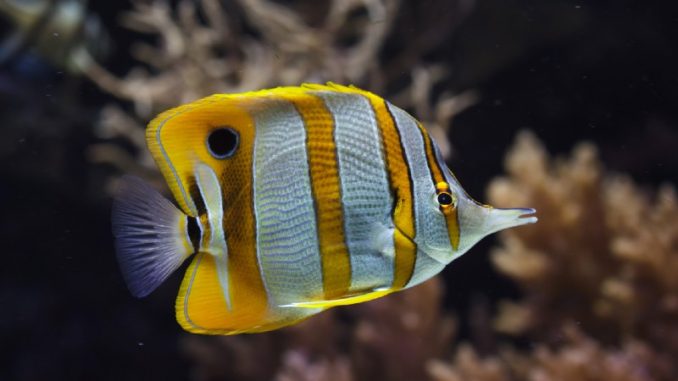
The copperband butterfly is a saltwater species of the butterflyfish family. There are 129 fish related to the copperband butterfly, including the Indian butterflyfish, the raccoon butterflyfish, and the teardrop butterflyfish.
Copperland butterflies are popular amongst aquarists due to their beautiful colors and patterns, despite their high care needs.
TABLE OF CONTENTS
Copperband Butterflyfish Facts & Overview
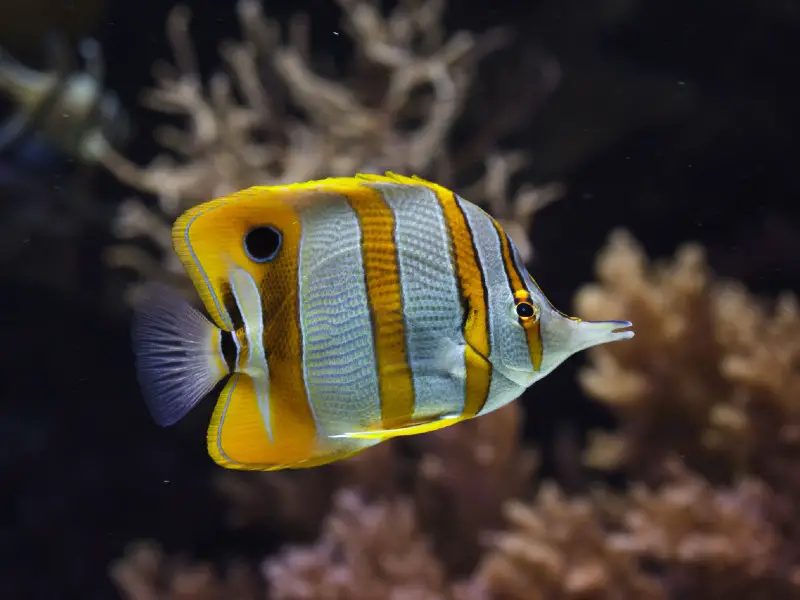
| Scientific name: | Chelmon rostratus |
| Common names | Copperband butterfly, copperband butterflyfish, longnose butterflyfish, banded longsnout butterflyfish, beaked coral fish, long-beaked coral fish |
| Distribution: | The Pacific and Indian Oceans in Indonesia, Australia, Singapore, and the Philippines |
| Size: | 4–6 inches |
| Life expectancy: | 6–10 years |
| Color: | White with yellow bands |
| Diet: | Carnivore |
| Temperament: | Aggressive |
| Minimum tank size: | 75 gallons |
| Temperature: | 75–78°F (23–26°C) |
| pH: | 8.1–8.4 |
| Hardness: | 5–15 dGH |
| Care level: | Moderate |
| Breeding: | Pelagic spawner |
Origin
The copperband butterfly is commonly found in saltwater reefs in the Indian and Pacific oceans around Indonesia, Australia, the Philippines, and Singapore.
Its natural habitat consists of corals and reefs, which provide shelters and territories for the fish.
Wild copperband butterflies live up to 80 feet under water, in reef slopes, shallow areas, and reef drop-offs. The waters in the fish’s natural habitat are warm, tropical, and alkaline.
Adult Size & Lifespan
Adult copperband butterflies grow to eight inches long in the wild. In captivity, the fish grow to 4–6 inches long. There’s no size difference between males and females.
The average lifespan of a copperband butterfly is six years. With the right care, they can live up to 10 years.
Availability
Copperband butterflies are widely available in saltwater fish stores and online. The average cost of a copperband butterfly is $80–$120.
You can buy these fish from the following online stores:
Appearance & Behavior
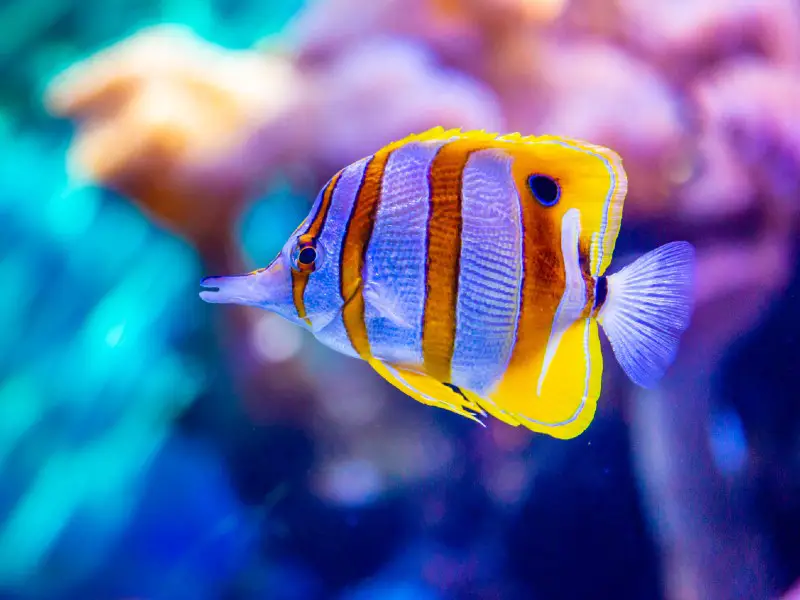
Copperband butterflies have triangular-shaped bodies with orange and white stripes. The fish are calm and gentle when housed with suitable tankmates, but are aggressive to other butterflyfish.
Colors, Patterns, Fins, and Sex Differences
The copperband butterfly has a white body with yellow vertical bands, outlined by small black stripes.
They have triangular-shaped bodies, with long, pointed snouts and large dorsal and anal fins.
At the tail end of the copperband butterfly’s dorsal fin is a black spot, resembling an eye. The base of the caudal fin is marked by a black stripe.
Males and females look virtually identical. Males have more steeply-sloped snouts than females.
Stress and diseases cause a copperband butterfly’s colors to fade. Feeding your fish a nutritious, high-protein diet will yield bolder, brighter colors than a poor-quality diet.
Copperband butterflies look similar to margined coralfish, but margined coralfish have fewer stripes and darker colors.
Typical Behavior
Copperband butterflies are generally peaceful fish. The fish show aggressive behaviors, including chasing and nipping, when they’re housed with inappropriate tank mates.
In an aquarium, copperband butterflies hunt for food amongst corals in the lower and middle sections. The fish use their long snouts to poke into small gaps and reach food that other fish can’t reach.
Copperband butterflies are fast, agile fish that swim in the open and dart to safety when they’re spooked. The fish are diurnal, meaning they’re more active in the day than at night.
Copperband Butterfly Care & Tank Requirements
Copperband butterflies are sensitive fish that have high care requirements. The fish require stable water parameters that mimic their natural saltwater habitat. Feed copperband butterflyfish a carnivorous diet.
Habitat and Tank Requirements
The copperband butterfly’s natural habitat is tropical, alkaline saltwater reefs around Australia and Indonesia. Mimic their habitat in captivity to ensure the fish is happy and healthy in the aquarium.
The minimum tank size for one copperband butterfly is 75 gallons to account for the fish’s large size and territorial tendencies. A tank of at least 125 gallons is required for two copperband butterflies, to prevent aggressive behavior between the fish.
Add a layer of sand, like aragonite sand, or crushed coral to the bottom of the tank. Use corals and rocks to create a reef-like environment with lots of caves, cracks, and crevices for the fish to explore and claim as their territories.
Copperband butterflies are known to nip at reefs when searching for food. However, the fish are considered a reef-safe species because they don’t deliberately attack corals, so it’s okay to house them in a tank with a large reef.
Tank Conditions
The ideal tank conditions for copperband butterflies are:
| Water type: | Alkaline, slow-moving saltwater |
| Tank size: | Minimum 75 gallons, or 125 gallons for two copperband butterflies |
| Water temperature: | 75–78°F |
| Substrate: | Fine sand or crushed coral |
| Tank setup: | Corals, rocks, caves |
| Acidity: | 8.1–8.4 pH |
| Water hardness: | 5–15 dGH |
| Filter: | Yes, copperband butterflies are sensitive to water quality, and a filter will keep water clean and clear |
| Bubbler: | Not necessary |
| Pump: | Yes, to provide water movement for gas exchange |
| Lighting: | Yes, to mimic the day-to-night cycles in the fish’s natural habitat |
| Water heater: | Yes, to keep the water temperature in the mid-to-high seventies |
Copperband butterflies are delicate fish that become easily stressed or diseased in changing water conditions. Ensure that water’s temperature, pH level, and hardness are well-maintained, and use a high-quality filter to keep the water clean.
Disease
Copperband butterflies are prone to a number of common saltwater diseases, including:
Saltwater Ich
Saltwater Ich, otherwise known as marine Ich, is a skin condition caused by Cryptocaryon irritans. Fish with saltwater Ich have irritated white spots on their bodies. Lethargy and loss of appetite are common saltwater Ich symptoms. Severe respiratory distress, irritation, and death can occur in untreated cases of saltwater Ich.
Treat saltwater Ich by moving the affected fish to a bare-bottomed treatment tank and adding controlled amounts of a copper treatment product to the water. UV sterilizers can also be used to kill Cryptocaryon irritans.
Lymphocystis
Lymphocystitis is a common fish disease caused by a genus of viruses called Lymphocystivirus. Raised, gray-white, light-colored nodules on the fish’s skin, either in clusters or individual spots, are the defining symptom of lymphocystis. The disease is caused by water quality issues and introducing infected fish into the tank without proper quarantine.
Lymphocystis can’t be treated, but fish can receive supportive care to prevent outbreaks of the virus. Decrease stressors in the tank by providing a nutritious diet and high-quality water.
Marine Velvet
Marine velvet is the saltwater variation of velvet, a fish disease caused by Amyloodinium ocellatum. This disease affects the skin and lungs, causing a dusting of brown-gold or green particles to form on the fish’s body.
Fish with velvet exhibit flashing — darting around the tank and rubbing on rough surfaces — lethargy, and clamping their fins close to their bodies. Later stages of marine velvet cause difficulty breathing and refusal of food.
Copper products are commonly used to treat velvet in a saltwater aquarium. Speak to your veterinarian about the fastest and most effective treatment.
Uronema marinum
Uronema marinum is a ciliate parasite that lives and feeds on fish. Large red sores are signs of uronema marinum.
Treat fish affected by this disease by soaking them in Metronidazole to prevent the disease from spreading internally, then moving the fish to a clean, sterilized quarantine tank to prevent reinfection. Uronema marinum can survive on detritus and dead tissue, so maintain a clean aquarium to minimize detritus — one of the parasite’s main food sources.
Tank Mates
Copperband butterflies can be housed in a community aquarium with compatible reef-friendly tank mates.
Don’t house copperband butterflies with other species of butterflyfish because the fish exhibit aggressive and territorial behavior toward one another. Invertebrates aren’t good tank mates for these fish because they feed on invertebrates in the wild.
Ideal tank mates for the copperband butterfly are:
Don’t overcrowd the tank with fish because this increases the potential for aggression amongst copperband butterflies.
Diet and Feeding
In the wild, copperband butterflies eat an invasive coral species called aiptasia, as well as worms, tiny shrimp, and fish fry. Replicate the fish’s carnivorous diet in captivity with a range of nutritious, protein-rich foods.
Copperband butterflies are difficult to feed, especially when first introduced to the tank. Stressed or nervous fish often refuse to feed. Prevent feeding issues by housing the new fish in a quarantine tank to reduce stress, then moving the fish to the community tank after two weeks.
Feed copperband butterflies live or frozen foods like mysid shrimp, brine shrimp, clams, bloodworms, and insect larvae. Experiment with different food types, prioritizing live foods, until you find a food that the fish readily accept.
Feed them high-protein, mineral-fortified pellets three times per week to ensure the fish’s nutritional needs are met.
Keep the water as clean as possible — copperband butterflies are more likely to eat in high-quality water conditions.
Provide a pinch of food two to three times per day. Don’t overfeed your fish because this puts stress on the fish’s digestive system.
Breeding
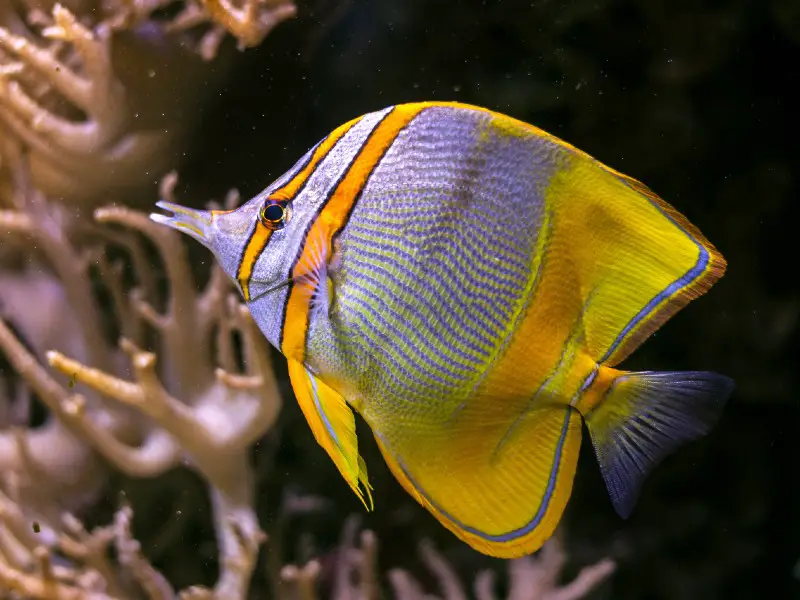
The copperband butterfly is one of the most difficult fish to breed in captivity. Only accomplished aquarists with a long history of successful breeding should consider breeding these fish.
There are very few reports of successful breeding of the copperband butterfly in captivity, and little information about how to encourage the fish to mate.
Attempting to breed copperband butterflies isn’t recommended because the fish are most likely to fight to death when housed together. Sexing these fish is also difficult because males and females are almost identical in appearance.
Should You Get a Copperband Butterfly for Your Aquarium?
Copperband butterflies are beautiful fish with higher care needs than most saltwater aquarium fish.
You should consider getting a copperband butterfly if you have experience in rearing saltwater fish and enough funds to design a reef tank tailored to these fish.
Don’t get a copperband butterfly if your existing tank contains incompatible fish or you don’t want to care for a high-maintenance fish with known feeding issues.
Despite their high care needs, these fish are colorful, interesting fish that are enjoyable to watch in a home aquarium.

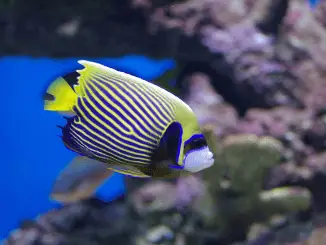
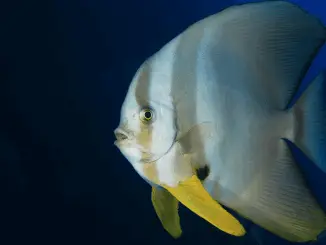
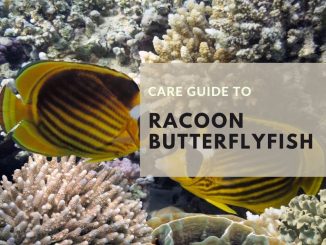
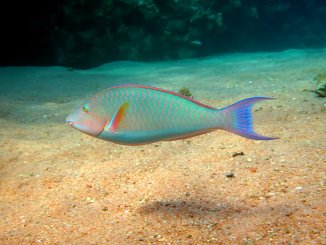
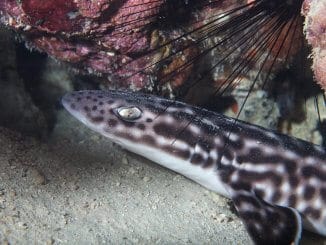
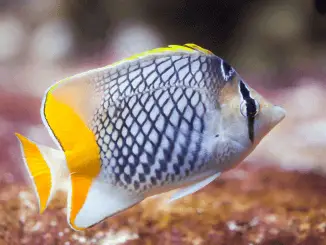
Be the first to comment